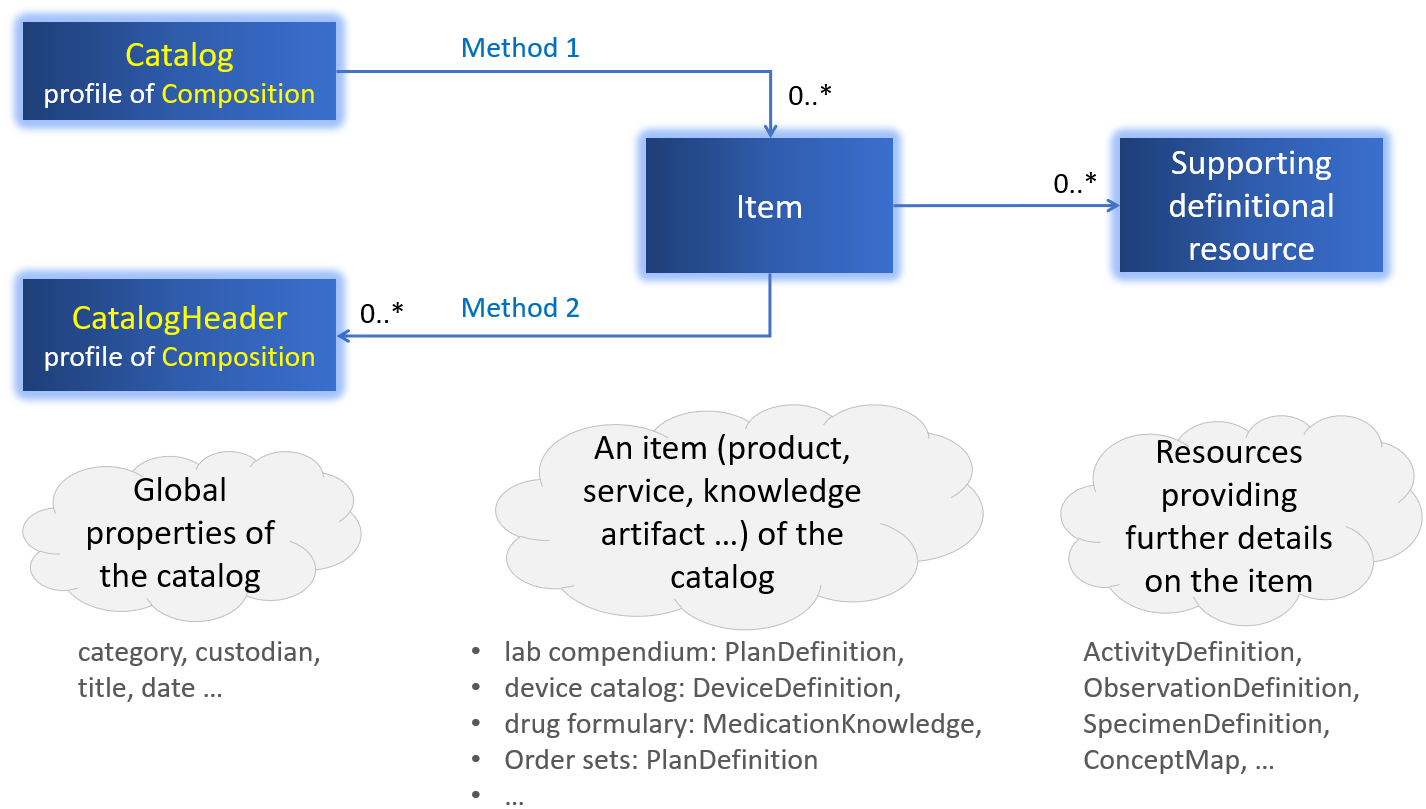This page is part of the Order Catalog Implementation Guide (v0.1.0: STU 1 Ballot 1) based on FHIR (HL7® FHIR® Standard) R4. No current official version has been published yet. For a full list of available versions, see the Directory of published versions
Contents:
| The scope of the current ballot is limited to the "laboratory service content" of this IG. Pages which are excluded from this ballot are signaled as such by a note to balloters at the top of the page. |
|---|
This implementation guide for sharing order catalogs is based on FHIR R4. Its scope is international (aka universal realm).
An order catalog exposes a homogeneous collection of healthcare items that can be ordered or selected by practitioners to support the course of healthcare delivery. These homogeneous healthcare items may represent services, products, devices or knowledge artifacts such as order sets, for instance. Each item specifies its purpose, describes how it should be ordered and/or used, and characterizes the outcomes that one can expect from its usage.
Examples of catalogs include order sets catalog, evidence based CDS content, laboratory test compendium, medication formulary, catalog of medical devices.
This universal realm implementation guide specifies the methods and artifacts based on the FHIR standard, to enable the sharing of catalogs of healthcare items across practitioners and organizations. The methods such as browsing, searching, retrieval, or maintaining the content, are common regarless of the catagory of catalog at hand: product, service, clinical knowledge... Some of the artifacts, like the one representing the catalog as a whole, are also common to all categories of catalogs. Other artifacts are specific to the category of items (medication, device, order set, diagnostic service ...) exposed by the catalog.
Considering these commonalities and specificities, building a common guidance for implementing any kind of catalog of healthcare items in FHIR has been deemed the most valuable proposition to implementers. Hence this unique Order Catalog Implementation Guide, which aims to cover all categories of catalogs of healthcare items. The use cases and artifacts (profiles, extensions, semantic resources) that are specific to a particular category of catalog will be placed under the responsibility of the HL7 Working Group defining the base resources for this category.
This IG is one of the product deliverables of project Ordering Service Interface Specification Project #1010, which is sponsored by Orders & Observations WG, and co-sponsored by Clinical Decision Support WG, Pharmacy WG, Imaging Integration WG and Service Oriented Architecture WG. The intention is that each work group contributes on its domain of expertise, to this cross-domain FHIR IG.
A catalog provides reference data, which aggregates requirements and guidance of usage for the items of the catalog, from multiple sources: regulatory, clinical knowledge, organizational (based on the organization of the provider of the items). These reference data are assembled under the stewardship of the catalog custodian: an organization liable for building and sharing the catalog, and maintaining it over time.
Catalogs are most often shared on servers which make them accessible to the practitioners through their IT systems or applications (e.g. EHR, EMR, CPOE, apps, LIS, Pharmacy system ...) Client applications may interact with a catalog server to:
Catalogs may also be exported in part or in whole to the consumer's system, using the FHIR messaging framework
Order catalogs have varied scopes, sizes, ownerships, stewardships and targetted consumers and jurisdictions. For instance an order catalog might expose the medical devices of a particular manufacturer to the potential users of these devices in a country. Another catalog might consolidate all the medical devices that are approved for use in healthcare throughout the European Union market. Another example of order catalog would be a drug formulary listing the medicinal products that are available for prescription in a particular hospital. A broader catalog of medicinal product might include all the medications authorized to the national market of a country. These examples illustrate various scopes and sizes of catalogs:
These examples also illustrate these roles involved in catalog interactions:
The roles of custodian and owner may belong to a single organization and in that case, be combined in a single system. Conversely, for some of the examples above these roles may be played by two distinct organizations, each with its own system, in which case, FHIR interactions are needed between these two roles to administer the content of the shared catalog.
The interactions between those three roles are described in the Interaction Framework of this guide.
The design choices presented here respect the flexibility requirements listed above.
In the FHIR standard, an order catalog as a whole is represented by an instance of the Composition resource, which conveys the general properties of the catalog (e.g. custodian, title, period of validity, type of content), and each item of the catalog is represented by a definitional resource, possibly associated with a set of supporting resources providing further details on this item. Two alternative methods are usable to bind the catalog as a whole to its items.

The catalog server must choose one of the two methods, and cannot mix the two methods for one catalog. Usable for catalogs of any size, the second method is in particular more appropriate for large catalogs because it makes the administration of the content easier. In particular, adding a new item or retiring an item does not impose any update to the Composition resource representing the catalog as a whole.
The main sections of this IG are:
| Role | Name | Organization |
|---|---|---|
| Primary Editor | François Macary | Phast |
| Primary Editor | Rob Hausam | Hausam Consulting LLC |
| Contributor | Freida Hall | Quest Diagnostics |
| Contributor | Gary Randman | Quest Diagnostics |
| Contributor | Kathy Walsh | LabCorp |
| Contributor | Andrea Pitkus | U of Wisconsin |